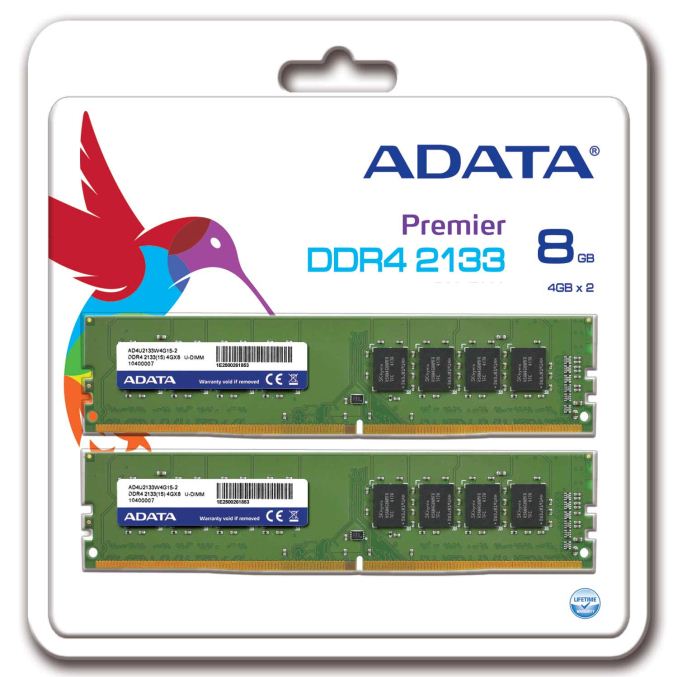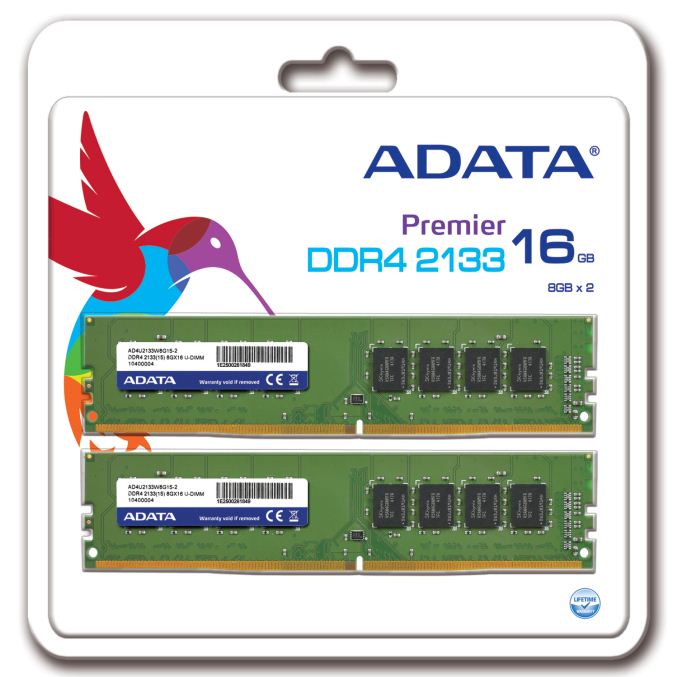ADATA Formally Announces DDR4-2133 CL15 UDIMMs
by Ian Cutress on July 31, 2014 5:17 PM EST
One of the hot topics in computer upgrades for the next couple of years is going to be the move to DDR4. Intel has already announced that the Haswell-E / X99 platform will be based on DDR4, and we can only assume that other future platforms will use it as well. The shift from DDR3 to DDR4 is a the big jump for DRAM manufacturers as well, shifting gears to the new product and maintaining stocks of both for the meantime. ADATA is one of the first to officially launch their consumer memory, their Premier line of DDR4.
JEDEC specifications have the DDR4 base frequency at 2133 MHz with sub-timing latencies of 15-15-15 at 1.2 volts. This is where ADATA will be positioning their first DDR4 modules in the market, and we can assume that others will as well until higher frequency parts are binned. Compare this to the rate of DDR3-2133, which is often at 10-12-12 timings or similar, but uses 1.65 volts, and typically comes with heatsinks.
Because we are far from the launch of a consumer platform for DDR4, as one might expect this comes across more as a paper launch. ADATA in the past typically publishes a PR about new memory about two weeks before it goes on the market, and I am asking about pricing which was not mentioned. Given the pictures we received with the modules, it would seem that 4GB and 8GB modules will be first to market for DDR4 unless another DRAM manufacturer has something up its sleeve.
Source: ADATA














28 Comments
View All Comments
vLsL2VnDmWjoTByaVLxb - Thursday, July 31, 2014 - link
"One of the hot topics in computer upgrades for the next couple of years is going to be the move from DDR4. "Think you mean "to"?
Ryan Smith - Thursday, July 31, 2014 - link
Indeed. Thanks for pointing that out; it has been corrected.invinciblegod - Thursday, July 31, 2014 - link
Does this even affect real world performance for a normal person (as in not for work related activities)? I've never been able to detect much difference in a gaming scenario.lagokc - Friday, August 1, 2014 - link
"Does this even affect real world performance for a normal person (as in not for work related activities)? I've never been able to detect much difference in a gaming scenario."If you're using integrated graphics? Absolutely yes for games. Otherwise probably not.
MrSpadge - Friday, August 1, 2014 - link
That's the wrong question to ask in the context of Haswell-E and X99. Anyone buying these is by definition not a normal person. Ask again once DDR4 hits meinstream platforms. For iGPU it will provide obvious benefits, whereas for regular operation you'll probably see a modest performance increase, equivalent to 1 or 2 CPU frequency bumps (it's been like that for DDR2 and 3 as well).Scabies - Thursday, July 31, 2014 - link
Using Anandtech's "Performance Index" (speed divided by CAS latency), this rates fairly low. Will all DDR4 start out this way or are we looking at a budget part here?Mr Perfect - Thursday, July 31, 2014 - link
It will probably all start out that way. DRR3 had high latencies when it first came out, DDR2 did to, and DDR1.... Actually, I don't remember how DDR1 compared to SD RAM anymore, but it certainly got better as it matured.B3an - Thursday, July 31, 2014 - link
It's stupid how a new DDR standard is always slower than the previous one when it starts out.DanNeely - Friday, August 1, 2014 - link
That should be inevitable. The ram manufacturers have years of experience tweaking parts for the old standard; but have only just figured out how to make the new one in mass quantities.CaedenV - Thursday, July 31, 2014 - link
It will absolutely get better with age. Think of this more like DDR3 800; it was a thing for a little while at launch, but was quickly bumped up to 1333 with lower latency, and then 1600+ as things went forward. We will have the better part of a year to get things a right before mainstream platforms start using this, so I would not worry about it.